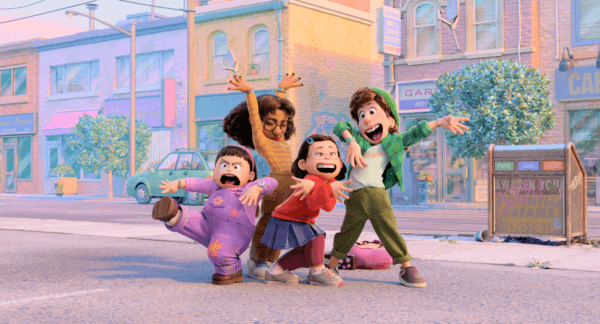We Can’t Keep Letting Businessmen Decide What Art Can Exist
Warner Bros. are going through some changes. Their recent merger with Discovery has seen the only female CEO in their history leave the company in favour of David Zaslav, a man looking to restructure the company’s strategy completely in a bid to clear $58 Billion of debt. Zaslav’s reign has begun with a mass execution of upcoming, ongoing and near complete projects with animation, predictably, feeling the heaviest blow from the guillotine.
Zaslav had a specific plan to scale down production of animation and kids ‘content,’ a grouping which reflects a misunderstanding of the broad audience animation can reach, let alone the animated shows and movies under the Warner umbrella (they literally own a channel called Adult Swim). Creators are also seeing their work wiped from Warner’s hugely successful streaming service, HBO Max. 36 titles were recently removed from the service, 23 of which were animated. Many of these projects only ever existed on the streamer, giving rise to an existential crisis for filmmakers. How is it that these people are allowed to simply wipe a piece of art from existence?
Backlash has not only come from creatives but from audiences too, exemplified in the comments on any social media post discussing the issue. Anticipated films like Scoob!: Holiday Haunt had production abruptly come to an end while beloved TV shows like Young Justice were announced to not be receiving new seasons. What the people want seems to be on the opposite end of the spectrum to what executives are doing. The power they hold, to decide who can tell stories, what art is allowed to last, to exist, is far too great to be in the hands of people who seemingly do not understand art to begin with. In the wake of the Warner controversy, audiences and creators alike are questioning how qualified these execs really are.
Multicultural Movie Making
The aperture between animation filmmakers and film execs can be attributed to their respective demographics. There is a narrow criteria for success in the business world that requires assimilation to an environment constructed and dominated by white men. Those who get the opportunities to direct the biggest projects in animation most commonly fit that description. A study from the USC Annenberg Inclusion found that only four women directed top animated movies between 2007 and 2018 out of 197 filmmakers in total. Just one of those women was a woman of colour.
However, as creative tools have become more democratised, marginalised people have found their voices heard through animation at an increasing rate. The modern animation landscape is a playground for people of colour, women and LGBTQIA+ folk to express themselves and finally have their unique stories told, whether that be on an independent stage or on a level of higher visibility. Two of the most celebrated movies to come from under the Disney umbrella in the last year, Turning Red and Encanto, are both animated movies from people and places that never get their stories told and have made mainstream animation the most exciting it has been for years.

“Two of the most celebrated movies to come from under the Disney umbrella in the last year, Turning Red and Encanto, are both animated movies from people and places that never get their stories told and have made mainstream animation the most exciting it has been for years” (Image © 2022 Disney/Pixar)
Therefore, Warner’s decision to turn their back on animated projects conjured dark clouds on what seemed to be a brighter future for animation. The stories that audiences yearn for, the ones that are unique, the ones that are covering untrodden ground, immigrant stories, insights into marginalised communities, pieces of work that inspire those who have never seen themselves on screen before, these are the stories that Warner’s executives don’t seem to appreciate, apparently unable to see why the expression of a brown person’s culture, of a queer or trans person’s experience or anything in that vein is important.
The whiteness of a board room is not a problem simply for aesthetic purposes, it has the opportunity to devalue film as an artform. White execs are more likely to see value in a white filmmaker which immediately places constrictions on what film can be. A recent UK Screen Alliance study proves how difficult it has been for UK animation to break out of its cycle of whiteness. Movies can create social movements and change attitudes, their capacity to do so is diminished if only white men are allowed to make them.
The Oxymoron of Capitalist Art
One could argue that the misunderstanding from execs extends far beyond art made by marginalised people but their devotion to creating capital means they misunderstand the purpose of art in general. Though the two have been married for a long time, it is becoming clearer that art and capitalism are enemies. Art is the embodiment of innovation, subversiveness and human emotion, an abstract, complex medium through which we aim to express the human condition. Capitalism is all about the cold repetition of what has squeezed the most pennies out of people before.
This is exemplified in the journey of mainstream animation since the mid 90s. CG animation was invented by and for artists as a new medium to express themselves through. This innovation could easily have existed alongside traditional 2D, hand drawn work, however, the lower production times and costs that CG afforded meant that hand drawn animation has slowly been dying out in the mainstream, all for the sake of making profit and churning out movies as if they’re fast food. Art provided an innovation which capitalism only understood as a money-saving scheme, devaluing the long tradition of 2D hand drawn animation which the industry is built on the back of.
When you only see art as something to profit off, you lack the tools to understand what makes it good or bad, all you see is numbers. Such a cold worldview finds its consequences in the infantilisation of animation and the categorisation of it as ‘kids content.’ Those whose brains are wired for conservatism are unable to process something as vibrant and innovative as animation continually is. Animation is sat at the kids’ table because of its power to create change, to give control to people that sit outside of the established corporate hierarchy.
This issue is not specific to Warner. At the start of the year, the UK government scrapped the BFI Young Audiences Content Fund, increasing the difficulty for creators, many of which work in animation, to have their films made. This, combined with prospective Prime Minister Rishi Sunak encouraging artists to retrain into IT-related fields, spells a dark future for filmmaking if nothing is done to stop the devaluation of the artform.
Let Artists Control Art
If there’s anyone who understands why art is important, why it’s vital for a diverse range of stories to be told, it will be the people telling them. For so long the film industry has perpetuated this myth that artists cannot be trusted with business decisions, that they need businesspeople to steer them in the right direction, to channel their vision into something consumable. Though great work has been made under these conditions, it has also led to a homogenous film landscape that is slowly strangling that which is unique.
As it stands, studios judge the quality of their movies on a binary – did it recover its budget or not? There is no room for the spectrum of opinion, no consideration of a cult fanbase. The aim for studios is for each and every movie to appeal to the widest audience. This ideology is antagonistic to what’s at the heart of creating film.
Major studios need to reframe what they expect from each individual release and have people in the room who can see the value in something beyond its ability to recover its budget. Look at a studio like A24, founded by former filmmakers, that consistently releases the most challenging and celebrated art year on year, all despite their titles not breaking the $100 million mark until earlier this year. Warner Bros.’ 2022 release The Batman grossed almost 7x its budget; surely this allows room to take a risk on an exciting young director from a marginalised background to make something potentially game changing, even if it doesn’t recoup?
It should not take convincing to give marginalised people a chance, filmmakers should not have their work defined by a box office number, they should not have their work infantilised and they should not have their work wiped from existence because someone unqualified to control art has decided that it should not exist. The film industry cannot survive while those who are anti-art are in control of art.


